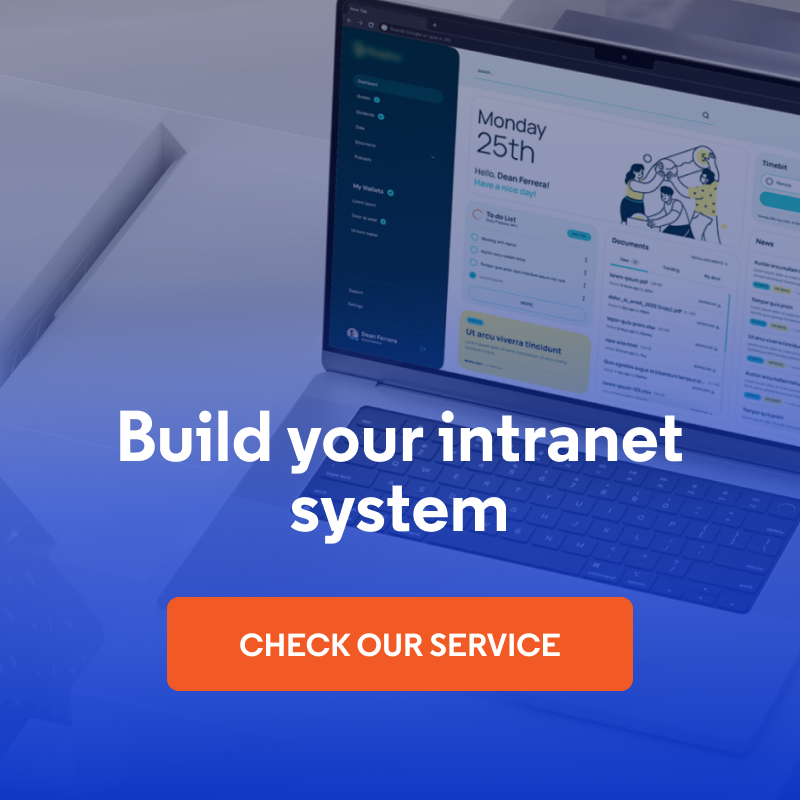
What is an Intranet and Why is it Worth Implementing in Your Company?
An intranet is a proven way to improve internal communication and knowledge management within a company, and has been used by organizations almost since the beginning of the Internet. Despite this, many companies still do not have such a system, and as a result face information chaos, duplication of work and lack of a single source of knowledge. If your company also faces these problems, read on to learn about the key benefits of implementing a modern and customized intranet.
In this article:
- What is an intranet and how does it work?
- Most common challenges of companies without an intranet
- The main benefits of successful intranet implementation
- Intranet as part of the company's development strategy
- What is an intranet? Summary
What is an intranet and how does it work?
An intranet is a private, internal work environment accessible only to authorized users. In practice, an intranet is a dedicated website, embedded in the corporate network, which gathers and provides employees with all the necessary resources - documents, procedures, announcements or collaboration tools.
The operation of the intranet is based on three pillars:
- authorization and security - users log in with a company account, and access to individual modules is controlled by roles and permissions.
- centralization of content - all files and messages are stored on a single web server or in the corporate cloud, eliminating the risk of knowledge dispersion.
- modular design - the intranet platform consists of independent sections (e.g. news, knowledge base, calendar, forum), which can be freely configured and extended with integrations (CRM, ERP, HR systems).
This allows the company intranet to act as a dynamic communication and information platform, improving onboarding of new employees, speeding up information retrieval, and automating repetitive processes within the company.
Differences between an intranet and a classic website
The website is public and aimed at a wide audience. It primarily offers information about the company's products, services, and image. It is the place where customers and partners learn about the organization's offerings, values, and achievements.
An intranet, on the other hand, is a closed, protected private network accessible only to employees, where, instead of marketing content, we find documents, procedures, announcements, and collaboration tools to support daily work. With it, we streamline internal processes, strengthen team commitment and ensure the security of company resources.
Who is the intranet software for and what are its purposes?
The intranet is aimed at all company departments - from management, HR, and marketing departments to technical teams. Its main goals are:
- improving communication among employees,
- reducing the time to find the necessary information,
- centralization of documentation and procedures,
- supporting the onboarding processes of new people.
Intranet as an internal communication and information platform
With an intranet, a company gains a single, consistent, and secure source of knowledge that reduces information clutter and repetitive questions. Employees can easily:
- publish and comment on announcements,
- share files and update document versions,
- use internal search functionality and resource directories,
- integrate the intranet with other systems (e.g., CRM, ERP) within a single interface.
As a result, the intranet software is transformed from a simple repository into a dynamic collaboration space tailored to the needs of modern organizations.
Most common challenges of companies without an intranet
In companies that do not use an intranet, a scattering of information appears very quickly - documents lie in different folders, on the desktop, in emails, or on network drives. Each department may have its own archive, which makes it take a long time to find current versions of files, and the risk of working on outdated data increases.
Another problem is an overabundance of emails and chaotic communications. Instead of sending a short announcement or a quick news item on one platform, organization’s employees often send out hundreds of messages in which the most important information gets lost. As a result, key messages end up in inboxes, where they get lost between irrelevant copies and replies.
The lack of a single, common source of company knowledge means that employees don't know where to find procedures, instructions or positive practices from other teams. This leads to duplicating mistakes, duplicating tasks and constantly trying again what someone else has already done - instead of using ready-made solutions.
Finally, without an intranet platform, onboarding new employees is cumbersome and time-consuming. New people have to rely on random files or verbally transmitted explanations, which significantly slows down the implementation process. The lack of a central platform also hinders interdepartmental cooperation—without effective knowledge sharing, teams struggle to exchange insights, and joint projects drag on as coordinating tasks and accessing resources become difficult.
The main benefits of successful intranet implementation
Implementing an intranet is an investment that pays off quickly, both in the form of time savings and better work organization. Below are the key benefits a company gains by opting for its own intranet system.
Centralized access to information
The intranet acts as a central repository where you store company policies, procedures, forms, and all key documents. Instead of digging through various folders on a shared drive or in email attachments, employees use a single, searchable database - so they can find the files they need in seconds.
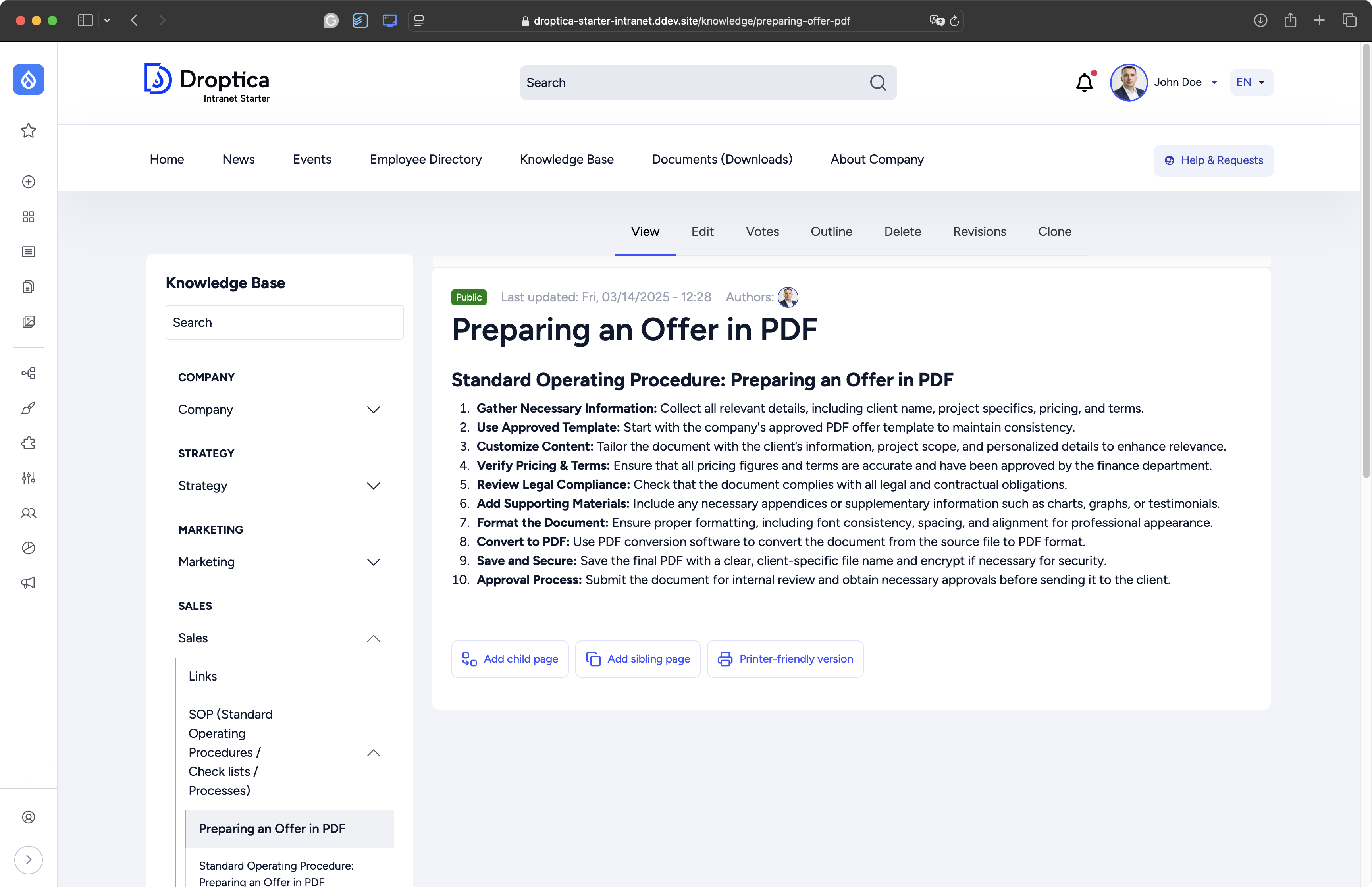
In addition to formal documents, the corporate intranet is also a natural place to gather and develop the company's internal knowledge base. Described processes, standards or best practices are no longer hiding in the heads of experts, but are available to everyone. New team members can refer to structured manuals and guides. At the same time, the entire team has a clear template for action - standards are consisten, and access to up-to-date information is guaranteed.
Regular updates and comments under the documents allow for continuous improvement of the knowledge base. As a result, the intranet becomes not just a place to store files, but a living encyclopedia of the organization that grows and adapts to changing working conditions.
Improving internal employee communication
Many companies struggle to keep employees informed about what’s happening in their organization—important announcements get lost in crowded email inboxes, and updates about changes must be sent out repeatedly. The intranet solves these challenges by providing a central bulletin board that publishes articles and announcements about internal policies, new programs, or ongoing recruitment processes. By integrating with other company systems, the intranet can automatically notify new publications by email, SMS, or through any channel chosen by the organization, significantly increasing the chance of reaching all employees.
Unlike mass emails, an intranet software offers a number of facilities that improve the quality and efficiency of internal communication.
Possibility of editing and supplementing
Posts on the intranet can be revised and expanded on an ongoing basis, without the need to send follow-up emails with corrections.
Easy linking and reusing
Instead of uploading files as attachments, simply link to an entry that can be embedded multiple times in your CRM, team page, or other tools.
Commenting features
Employees can discuss directly under the article, clarify doubts, and share ideas.
Permanent archive available to everyone
Older communications remain on the intranet platform as a living knowledge base - new employees can access them right away, without having to search their email inboxes.
Reducing chaos in inboxes
Key company information is not lost between dozens of emails; everything is in one organized place.
With these capabilities, the company intranet becomes not only a publishing tool but also an interactive platform that fosters employee engagement and enhances the flow of information.
Increase employee engagement
In larger organizations, it's easy to feel isolated. Employees are focused on tasks in their own departments and may not feel connected to the company as a whole. Modern intranets help break this fragmented model by offering a space where everyone can see what's going on in other teams, learn about strategic goals, and celebrate successes together.
For example, company events - conferences, meetups, or team-building meetings - can be documented and published on the intranet. Photos and videos also go to teams when someone couldn't attend in person. Like, comment, and share functions encourage interaction, which in turn builds a sense of community and belonging.
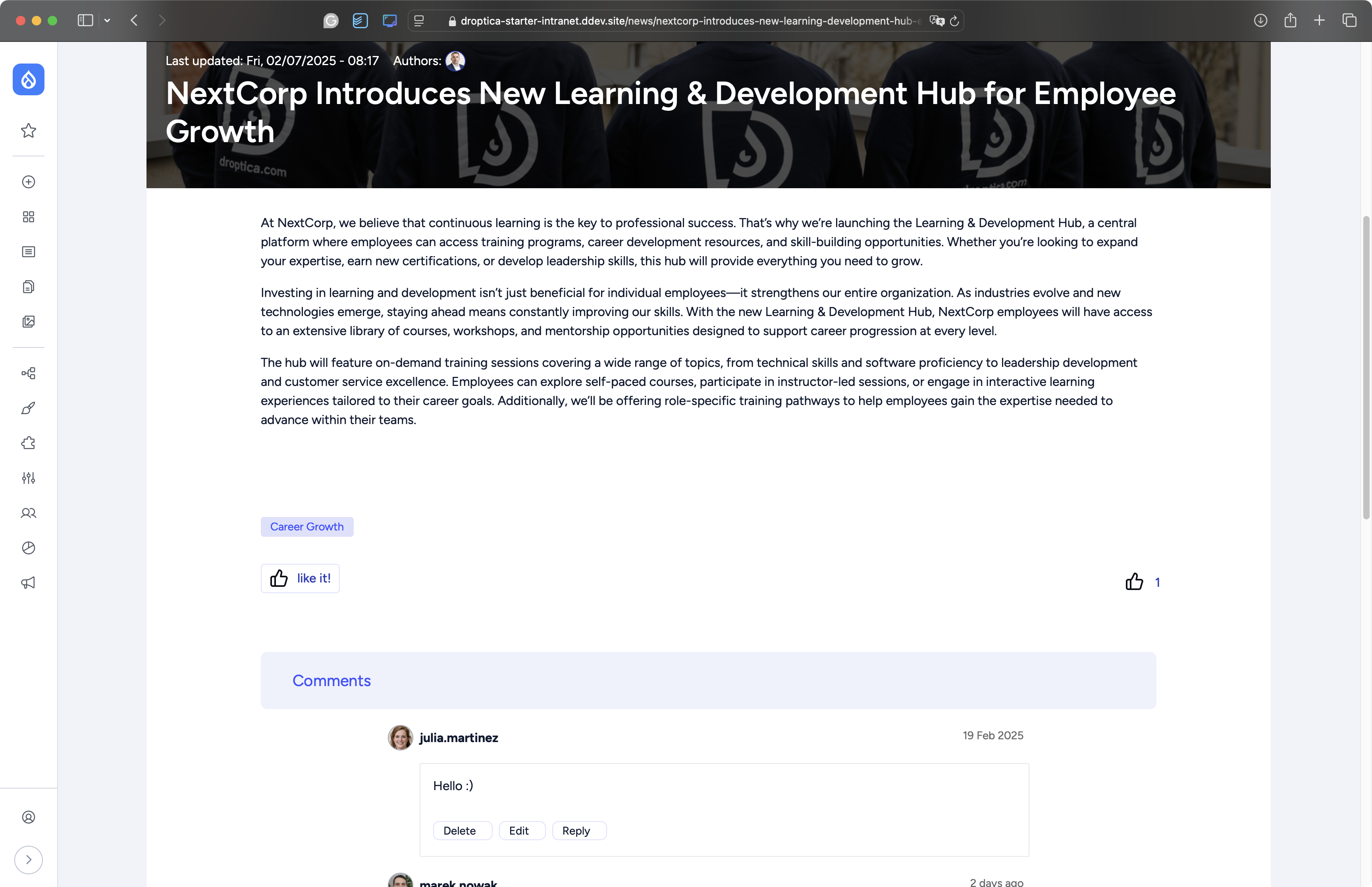
The intranet is also an ideal place to present the company's strategy and explain what assumptions guide each management decision. This helps employees understand their goals in a broader context and how their daily work contributes to the organization's mission.
Nothing mobilizes like success stories. It is worth publishing on the intranet:
- case studies from successful projects, showing the path from challenge to effect,
- information on awards and prizes won,
- individual successes, such as exams passed, certificates, or innovations developed.
In addition, the "Meet the Team" section allows you to create profiles of employees from different departments. Meanwhile, short interviews or articles about what the marketing department does and what the IT department does help to understand the interdependencies and emphasize that everyone "plays to one goal."
Automation of repetitive processes
Many routine tasks in a company require the transmission of documents, approvals, or data collection, which is often done in different systems or via email. An intranet allows you to move these business processes into a single, automated environment, where employees fill out an online form and the appropriate people receive automatic notification of the next steps.
With workflow modules, you can create ready-made approval paths for your most important procedures. Instead of monitoring your email inbox and keeping an eye on deadlines, the intranet site sends reminders and informs you of approvals or the need to complete documents. Everything is done within a single platform, which significantly reduces the risk of lost requests or delays.
The most commonly automated processes are:
- Leave submission and approval - the employee fills out the application, which goes automatically to the supervisor, and after approval it goes to the HR and payroll system.
- Requests for expenditures and settlements - invoices and bills sent through the form, with a category designation, immediately go to the finance department.
- Acceptance of company policies and procedures - new or updated instructions are sent to the relevant teams with a request to confirm that they have read the content.
- Handling IT and service requests - requests for technical problems go to the helpdesk, prioritizing and tracking the status of repairs.
As a result, the intranet software not only speeds up the execution of routine tasks but also increases process transparency, minimizes human error, and allows for constant monitoring of operations' efficiency.
Improving processes in the HR department
With an intranet, the HR department gains a quick and transparent way to manage key HR processes, eliminating paper chaos and hundreds of hours spent sending emails.
- Leave requests - employees submit requests on the intranet and supervisors approve them by clicking; the system automatically updates the leave calendar and notifies the finance department.
- Sick leave - a copy of the certificate goes straight to HR, and the team can see when the employee returns to work.
- Performance reviews - managers and employees can fill out and review evaluation forms and note goals for the next period, keeping a full history of development conversations.
- Entrusting company property - recording the assignment of laptops, phones, or access cards is done in the equipment module, with automatic reminders for the inspection and return of assigned devices.
Instead of laboriously sending documents by email or paper, the company intranet provides asynchronous communication where all concerned can see the current status of each request. This saves the HR department hundreds of hours a year, while employees can check the status of their application at any time, plan their return from leave, and ensure that no information gets lost in the inbox.
Support for remote and hybrid working
For distributed teams, the intranet becomes the main access point to all company resources - whether employees are in the office, at home, or on the road. This ensures that everyone has the same tools and relevant information at their fingertips, eliminating a sense of exclusion and allowing them to plan tasks efficiently.
Key intranet elements supporting the remote and hybrid model:
Easy access from any device
Employees log in to the intranet site via a browser or dedicated mobile app, gaining the same interface and functions on a computer, tablet, or smartphone.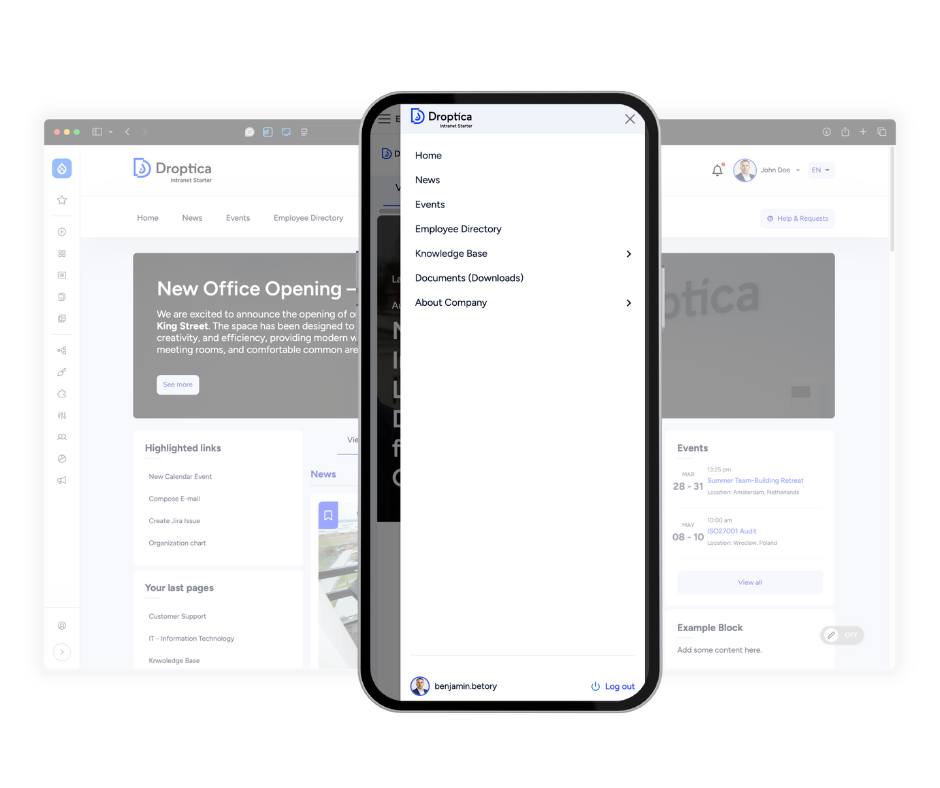
Asynchronous communication
With internal discussion threads, comments under documents, and bulletin boards, teams can engage in knowledge sharing without the need for live meetings.
Common tools for teamwork
Integrated calendars, task lists, and project management modules allow you to track progress without switching between multiple applications.
Secure access and compliance
The intranet uses SSO authentication and encrypted VPN/HTTPS connections to ensure data protection even when using public Wi-Fi networks.
Automatic synchronizations and notifications
Document changes, new entries, or required actions can be automatically sent via email, SMS, or internal alerts, so your team doesn't waste time manually checking for updates.
Integrations with video conferencing tools
Direct links to meetings in Zoom, Teams, or Google Meet, embedded in the intranet's calendar, allow you to quickly switch between scheduling and video calls.
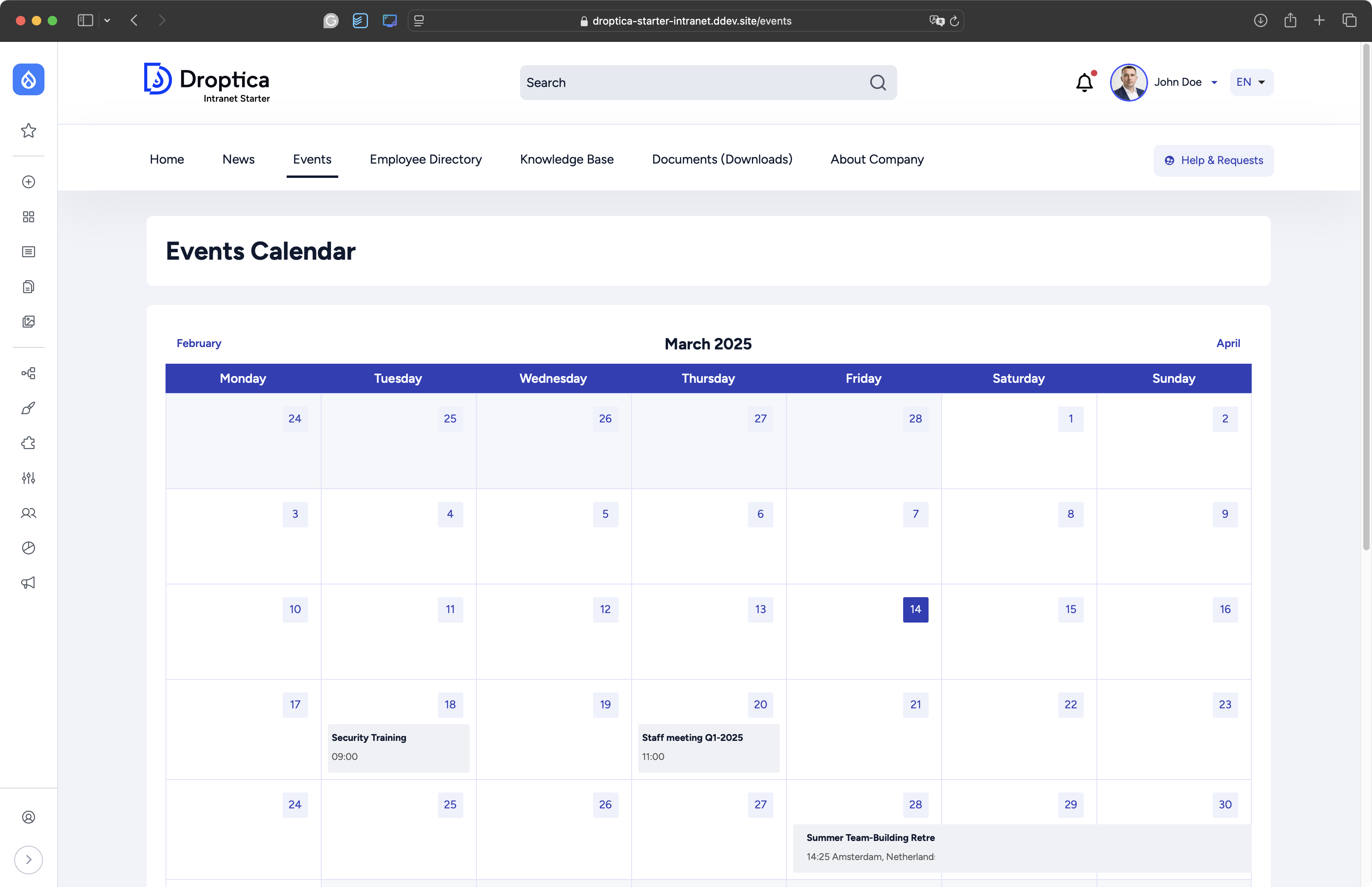
Composed in this way, the company intranet provides a consistent and secure digital workplace in which hybrid and remote workers feel as engaged and informed as stationary employees.
Increase efficiency of teams
A well-designed intranet helps teams work faster and better, eliminating unnecessary downtime and improving task coordination. With central access to company information and tools, every team member knows what they are responsible for and what the priorities are.
Clear division of roles and tasks
Project boards and task lists on the intranet show who is working on what, their deadlines, and current statuses, avoiding duplication of effort.
Real-time KPI dashboards and reports
The team can track KPIs in real time, and managers can see progress without having to ask for additional data or weekly meetings.
Automatic deadline reminders
The system sends notifications about upcoming deadlines, tasks awaiting approval, or new comments, reducing the risk of delays.
Easy access to resources and expertise
A built-in search functionality and subject categories allow you to quickly find relevant materials, procedures, or people who can help with a particular task.
Integrations with project management tools
Combining your intranet with task management tools like Jira, Asana, or Trello provides a consistent digital workspace where all tasks and documents are synchronized.
Less time in status meetings
With up-to-date data available online, employees spend less time in unnecessary meetings, able to focus on achieving goals.
As a result, teams gain transparency, better coordination, and more control over project progress, resulting in faster results delivery and higher-quality work.
Centralization of information from multiple systems
In many companies, data is scattered across applications ranging from time tracking tools to financial analysis and sales forecasting systems to KPI dashboards. Each system has its own interface and sometimes requires the installation of additional software. An intranet allows you to gather all this information in one place and make it available to employees in a simple, consistent way.
Integration through APIs
Through open interfaces (APIs), the intranet connects to existing systems, such as CRM, ERP, analytical tools, or online learning platforms, and pulls key data from them.
Friendly visualizations
Instead of logging into several applications, users will see charts, tables, or financial summaries on the intranet platform in easy-to-read widgets, embedded directly on the homepage or in dedicated cockpits.
Unified user interface
Employees use a single, consistent environment - they don't have to remember multiple passwords or install different programs. All they need is a browser or the intranet's mobile app.
Real-time updates
Data is uploaded in real time, so everyone sees the latest sales results, KPIs, or project statuses without having to manually refresh or export reports.
This makes the intranet not only a place to post announcements, but also a universal control panel for company processes and data, tailored to each team's needs.
Intranet as part of the company's development strategy
An intranet is not only an operational tool, but also an important part of an organization's long-term strategy. Properly implemented and used, an intranet supports a company's culture, facilitates faster scaling of operations, and secures sensitive data, which translates into real business benefits.
Impact on company culture
The intranet shapes a cohesive company culture, as it allows for transparent internal communication and reinforces a sense of community and belonging. With regular updates, articles about team successes, or employee profiles, everyone can see the broader context of the organization's activities and values. By enabling joint competitions, surveys, or mentoring programs directly on the internal communications platform, the company builds employee engagement and strengthens relationships between departments.
Making it easier to scale the business
As the company grows, new teams, offices, or projects arrive - the intranet scales with it. A central repository of documents and ready-made process templates allows new people to be brought in quickly, and the intranet's modular architecture makes it possible to add more features (e.g. recruitment module, CRM, e-learning) without having to rebuild the entire system. As a result, the company can enter new markets or increase the volume of projects handled without losing the quality and consistency of its operations.
Improving data security - ISO27001 compliance
Information security is an absolute must today. An intranet implemented in accordance with ISO27001 standards facilitates the introduction and oversight of security policies, access control, and audit procedures. In this way, the organization minimizes the risk of confidential data leakage or unauthorized access, while meeting the expectations of customers and business partners, who increasingly require proof of compliance with international standards.
What is an intranet? Summary
An intranet is not only a modern internal communication tool but, above all, a key to efficient collaboration, knowledge centralization, and automation of repetitive processes. It gives faster access to information, better employee engagement, and support for remote work.
Our free Open Intranet tool includes a set of ready-to-use functionalities, such as:
- bulletin board and publication of articles,
- knowledge base,
- employee directory,
- document and file version management,
- forms and workflows to automate processes (leaves, approvals),
- integrations with CRM, ERP systems, and HR tools.
What's more, Open Intranet can be fully customized - from the interface design, to the data structure, to dedicated modules, tailored to your industry or organization size. We will be happy to tell you more about the capabilities of our intranet system during a free consultation.
***
Updated article dated 31/07/2020


